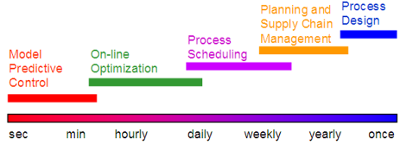Combined Scheduling and Control
Current process control and optimization strategies are typically divided in three major sections: base layer controls, advanced controls, and planning and scheduling. Each of these levels works at a different time scale, ranging from milliseconds to seconds for base controls, up to months or years at the planning and scheduling level.

In an effort to simplify models and decrease computation time, each of these layers receives a minimal amount of information to fulfill its objective. However, this lack of information creates lost opportunities. For example, the scheduling program may pass a set of unreachable set points to the advanced controls, or the base controls could reach a set point through a suboptimal path due to its lack of knowledge regarding process nonlinearities that the advanced controls had incorporated.
This control structure is largely an artifact of the development of process control and the computational limits during these developmental periods. Computers are far more advanced today so the segregated control structure is being reanalyzed.
Our team is investigating methods to overcome the deficiencies of the segregated system while maintaining robust and timely optimizations for both scheduling and control objectives. These novel algorithms are applied to petrochemical processes, such as the UNIPOL™ reactor, for testing.
Support for this research comes from the Nation Science Foundation, Award 1547110.
- Beal, L.D., Petersen, D., Grimsman, D., Warnick, S., Hedengren, J.D., Integrated Scheduling and Control in Discrete-time with Dynamic Parameters and Constraints, Computers & Chemical Engineering, 115, pp. 361-376, 2018. Article
- Hedengren, J.D., Beal, L., Special Issue: Combined Scheduling and Control, Processes, 6(3), 24, doi: 10.3390/pr6030024, 2018. Editorial and Special Issue
- Beal, L.D., Petersen D., Pila G., Davis, B., Warnick, S., and Hedengren, J.D., Economic Benefit from Progressive Integration of Scheduling and Control for Continuous Chemical Processes, Processes, 5(4), 84, doi:10.3390/pr5040084, 2017. Article (Open Access)
- Petersen, D., Beal, L.D., Prestwich D., Warnick, S., and Hedengren, J. D., Combined Noncyclic Scheduling and Advanced Control for Continuous Chemical Processes, Processes, 2017, Processes, 5(4), 83, doi:10.3390/pr5040083, 2017. Article (Open Access)
- Udy, J., Hansen, B., Maddux, S., Peterson, D., Heilner, S., Stevens, K., Lignell, D., Hedengren, J.D., Review of Field Development Optimization of Waterflooding, EOR, and Well Placement Focusing on History Matching and Optimization Algorithms, Processes, 5(3), 34, 2017, doi:10.3390/pr5030034. Article (Open Access)
- Beal, L., Park, J., Petersen, D., Warnick, S., Hedengren, J.D., Combined Model Predictive Control and Scheduling with Dominant Time Constant Compensation, Computers & Chemical Engineering, 104, pp. 271-282, 2017, doi: 10.1016/j.compchemeng.2017.04.024 Article
- Beal, L., Park, J., Petersen, D., Warnick, S., Hedengren, J.D., Combined Model Predictive Control and Scheduling with Dominant Time Constant Compensation, Computers & Chemical Engineering, 104, pp. 271-282, 2017, doi: 10.1016/j.compchemeng.2017.04.024 Article
- Mojica, J.L., Petersen, D.J., Hansen, B., Powell, K.M., Hedengren, J.D., Optimal Combined Long-Term Facility Design and Short-Term Operational Strategy for CHP Capacity Investments, Energy, 118, pp. 97–115, 2017. Article
